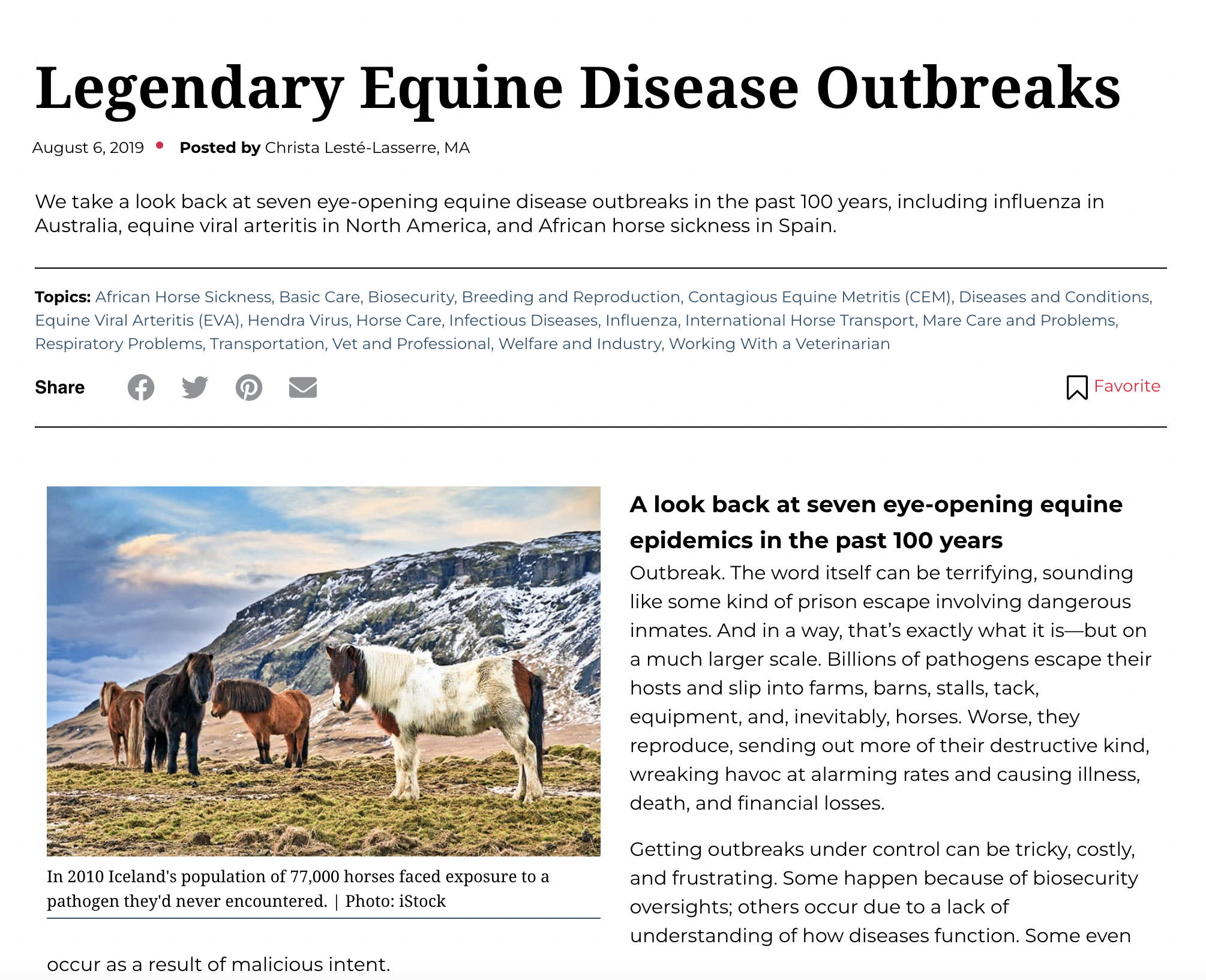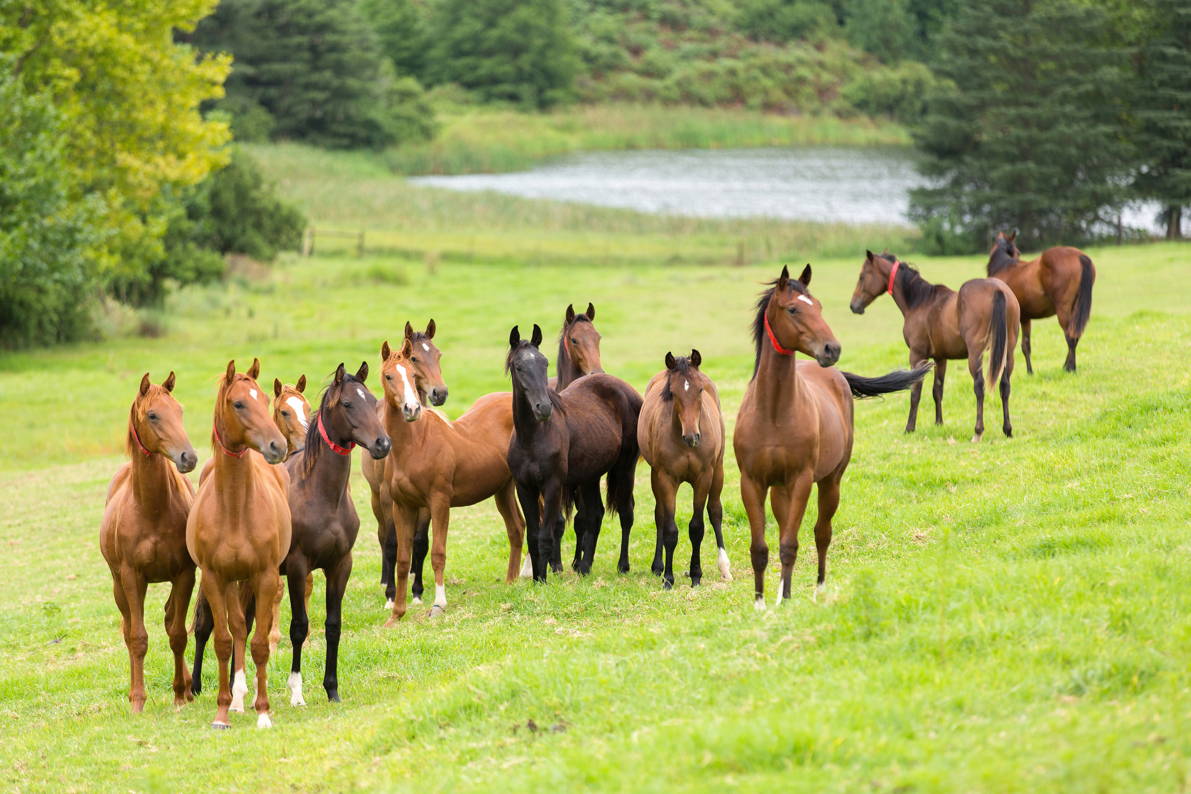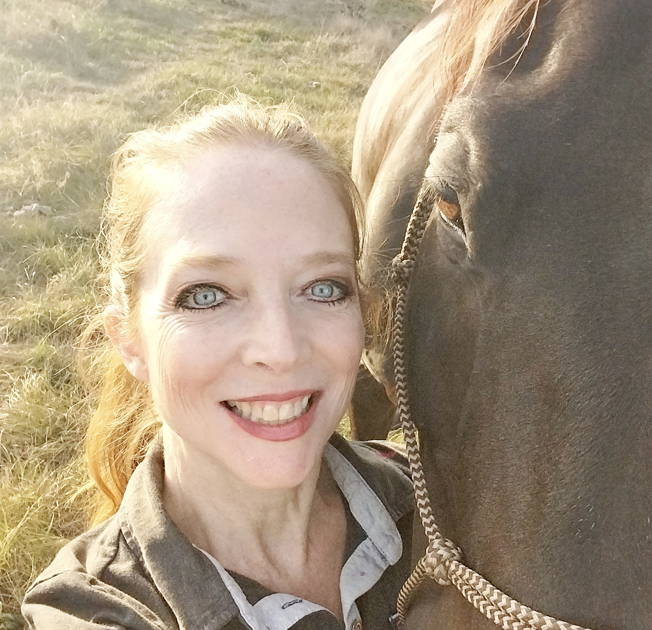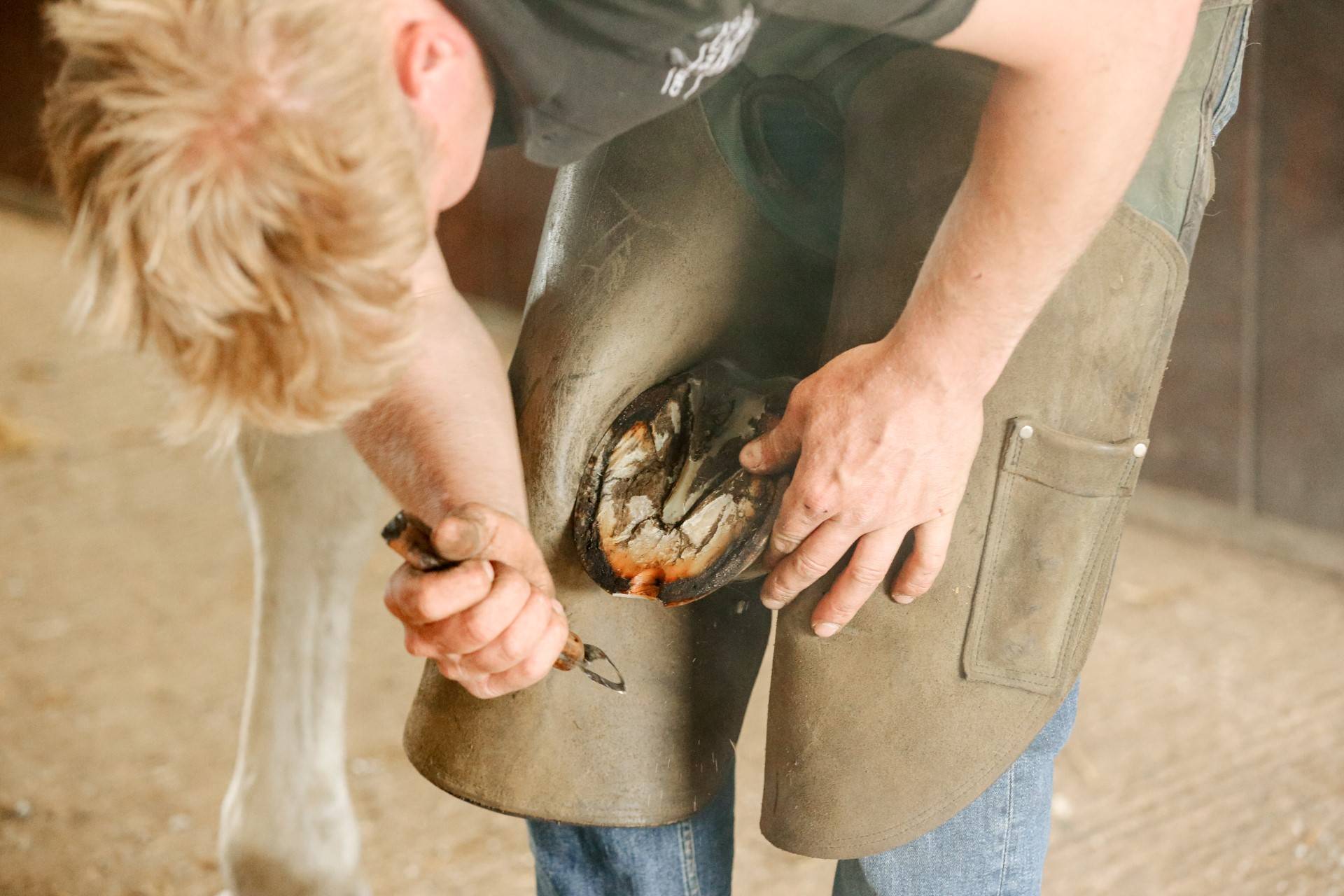Horsemanship Lessons Learned
By Christa Lesté-Lasserre
I started my equine science journalism career at a moment when things were moving fast, and knowledge was rapidly building. Imaging techniques and laboratory analyses were suddenly improving, for example. The internet was exploding with opportunities for science-minded people to share information worldwide. And scientists at Cornell University had just decoded horses’ DNA by mapping the full genome of a Thoroughbred named Twilight—an event I was fortunate enough to not only write about, but receive awards for.
It was around that same time that people—and especially scientists—were starting to seriously investigate what horses see, hear, smell, and feel. The behavior research team in Rennes, France, was really digging into greater knowledge about what horses want and like, and another French team was delving into a better understandings of horses’ personalities, as the Swiss stepped up their already solid welfare research by looking into better ways to keep horses—including stallions—and to understand why they do the things we don’t want them to do.
Meanwhile, on the other side of the globe in Sydney, Australia, a tiny international group was forming the brand-new scientific field that they named “equitation science.”

This all got the equine science journalism ball rolling at high speed—not only for the magazines I wrote for, but also in my own mind. As an owner of two Trakehners that I’ve kept at home as well as in boarding stables, every single topic I’ve written about and interviewed people about has hit home, in some way or another.
It’s absolutely impossible to narrow down everything I’ve learned into a single article. And, to be honest, this piece might be the most challenging I’ve ever written! But at the very least, I can narrow the task down to five of the most significant lessons I’ve learned as a horse owner writing about horse health and welfare science.
1. Spend More Time in Quiet Observation than Anything Else
Riding and training can certainly provide a lot of opportunities to build relationships with my horses. But for every hour I’m in the saddle or doing ground training, I like to spend two or three—or ideally even more—just being in the quiet presence of my horses.
The importance of quiet observation really hit home when I was interviewing Elke Hartmann, PhD, at the Swedish University of Agricultural Sciences, in Uppsala. We were talking about herd dynamics, and I asked her for tips about managing owners’ herd. Her main answer was simple, yet wise.
She said: Observe them. Not as in just watching them for five minutes admiring how beautiful they are. Observe them. Take a Thermos and a folding chair, and paper and pencil, or camera, and pay attention to what each one likes to do and where each one likes to be, who stands next to whom the most, who steps out of the way of whom in different situations, and every other detail you can gather.
I started following Hartmann’s advice after that interview. I learned a lot about herd dynamics, just as she said I would.
But unexpectedly, I also learned what’s normal for each horse in the field. These observation times gave me a picture of how much and how often each horse lay down, ate, drank, scratched, and slept on three legs, as well as information about particular forage and shade preferences, and his or her typical postures and facial expressions.
All that “normal” information became especially important later, as a gauge. In effect, that knowledge let me know when something was not normal for that particular horse—which, in this quiet species, is often the first early sign of pain, internal illness, or a welfare issue.
Observation time is also a great way to take “horse language” lessons. Like spending an afternoon in a Spanish or Italian countryside, I can find myself immersed in this foreign language when spending quiet time with my horses. We humans are far less subtle in our movements—which must come across as a really strong “accent” to equids! But with quiet observation, we can start becoming more sensitive to some of the body language horses use to communicate.

And since researchers evaluate “friendships” between horses based on how close they stand to each other how much they scratch each other’s withers, I find this quiet pasture time an interesting gauge of my horse-human relationship as well.
True, I’m not a horse, and I would never consider my horses unintelligent enough to “see” me as a horse. But I do consider them intelligent enough to see me as another sentient being. If I make myself available, how much will my horses choose to stand next to me? How much will they scratch me if I scratch them? I’ve found that this behaviour can vary over time. If they start keeping a greater distance from me, I might need to rethink some of my recent training with them, or get my tack refitted.
Finally, most of this quiet observation can—and should—also happen in the saddle or during ground work. We spend a lot of our riding and training time talking to other people or our horses. But there’s so much to be learned by spending that time listening to our horses instead: paying attention to their normal hoof beats and respiration, and reading their body language. I suspect that they probably appreciate the quiet, too. And I feel like it helps develop the horse-human bond.
2. Know Risk Factors for Everything Relevant to Us
Colic, laminitis, gastric ulcers, corneal ulcers, heaves, hives, infectious diseases, cribbing and weaving, tendinitis, puncture wounds, sore feet, dental disease, ataxia, running loose, getting stressed, getting depressed, getting cast, getting dehydrated, getting undernourished, getting overnourished…
I couldn’t possibly list everything that might happen to horses—nor everything I’ve learned from writing about them. But what I can say is this: I’m keenly aware that pretty much any of these things might happen to my horses. As an equine science journalist, I find that it’s easy to get overwhelmed thinking of all the catastrophes lurking around every corner.
But that takes away so much of the joy of horse ownership.
I now know that the best I can do is be aware of the risks, and especially the risk factors. That includes general risk factors that apply to all horses, like shifting weight off an injured hindlimb, which can lead to supporting limb laminitis in the other.

But that also includes knowing the more specific risk factors related to our unique situation: What are the risks for my horse’s breed, discipline, and family history? What about those related to our geographic location, climate, neighbouring horses, wild animals, and insects? And those related to my management options like pasture size, terrain, fencing, shelters, shade, grasses, and water sources?
By being aware of the risk factors that apply to us, I can make better decisions to help avoid many health and welfare issues. And I can be more prepared to recognize and deal with them if they do occur.
3. Maintain a Fantastic Relationship with My Vet, Farrier, and Nutritionist
Horses are notoriously good at doing stupid things sometimes, despite their amazing levels of intelligence. (Oh I don’t blame them! I am, too. And I’m certainly nowhere near as intelligent.)
My experience as a writer has shown me that not only can horses find themselves in ridiculously dangerous predicaments as they navigate our domestic world—but also that our care for them is key to their good health and well-being. That concept really struck home when the former president of the Swiss Equestrian Federation, equine veterinarian Charles Trolliet, recently said to me: “Horses would probably have never survived evolution if they hadn’t been domesticated.”
As such, I just can’t express how much I value the excellent work of the professionals who care for my horses. They are absolutely a shining light in a world that’s often fraught with chaos, difficulty, bad weather, distance, and criticism.
I know they’ve gone through countless, rigorous academic trials and financial difficulties—often including huge debts—just because they love horses enough to want to learn what they need to know to help them. I have learned that their lives are so hard, and their push against adversity so great, that veterinarians have a suicide rate that’s four times higher than the average population, prompting the Not One More Vet campaign. And meanwhile, the rate of equine vets in particular is dwindling rapidly.
I’ve always wanted my vets to know that I appreciate them. And through my work as a science journalist, I’ve never wanted to express it so clearly as I do now. So here’s a message to all you equine vets, as well as other horse healthcare professionals out there: You are loved and greatly appreciated! Thank you for everything you do to make the lives of my horses better.
One thing I’ve learned as an equestrian journalist is that I so desperately wish that every owner would show that same gratitude to their hard-working, well-trained horse care professionals.
As an equine health journalist, I’ve seen endless cases of horses suffering and/or succumbing to health problems because a vet couldn’t get out to them despite their best efforts, or because the owners didn’t prioritize their animals’ healthcare. Again and again, I have hated seeing horses become the victims of their owners’ bad decisions—including their choices to cultivate poor relationships with their horses’ vets, farriers, and other healthcare professionals.
It’s really great to express appreciation through our words, both spoken and even on paper or via email in messages to those professionals. But it’s also important to pay these professionals their requested fees—in a timely manner—to underline our respect for their work.
My greatest healthcare challenge as a horse owner—and especially as an equestrian healthcare journalist—has been obtaining good foot care for my horses. It’s somewhat paradoxical, since my work has led me to understand the importance of quality, evidence-based farriery—which is, sadly, harder to find than I’d like. I can’t deny that I have literally had to make the choice between no farriery at all, or bad farriery. And I’ve chosen the former.
So when I finally found a truly good farrier, believe me, I have done everything it takes to keep him. It meant breaking boundaries at the boarding stable by refusing the kind of care offered by the stable’s regular farrier, and then convincing my own farrier to tread on the boarding stable’s ground and paying the added miles for him to get there. I’m glad I did. My horses’ feet have never been healthier. And I found a farrier that really follows science, listens to me and my concerns, and makes himself available.
Today, I’ve got a vet, farrier, and nutritionist who respond to my text messages, even off-hours. I can send them photos and ask for their advice. We work as a team, for the benefit of my horses. As for the other professionals—dentists and physical therapists, for example—they’re an important part of the team as well, although in our particular case we haven’t needed their interventions beyond yearly check ups so far. Still, they’re paid on time and understand that they’re deeply appreciated.

I can read all I want and write all I want about horse health and welfare, and what should or shouldn’t be done. But in the end, it takes a team—a professional team—to ensure my horses’ well-being. I’m happy and eager to cooperate in my role as the horse-owner part of the team. It’s not only decent and respectful, but also very positive for my horses’ good health and welfare.
4. Never, Ever Stop Questioning and Learning
I write about hard, true research into horse health and welfare. I generally won’t write about anything that isn’t stringently reviewed and published in highly reputable journals or presented during very serious and well-known conferences.
As such, it’s easy for me to fall into a trap of believing that everything I write comes from the strictest and most absolute truth.
The reality, though, is that science—by nature— is a world of improvement. Species adapt to life on this planet by learning, selecting, and getting better and better. Scientists do something really similar. While they aim to gather the most certain and absolute truths through their evidence-aimed research, they also know—and even hope—that one day, another group of scientists will build on that research and knowledge, and possibly find slightly different conclusions.
As such, this is probably the absolutely truest part of science: Scientific findings can only get truer and truer—or less and less true—with more research.
Does this mean I distrust science? Not in the slightest. Scientific research is an organic process of progress and learning. Most of the time, it’s headed in the right direction and gets refined over time. Very, very occasionally, its ideas get overturned.
I choose to trust science—while also choosing to keep track of how scientific research is evolving. In other words, if I rely on something I’ve learned through evidence-based studies, you can guarantee that I’m following up on that evidence by reading any new materials that support, build on, or contradict that evidence. (For the record, that’s super easy: all it takes is setting up an alert on various websites for emails that flag updates.)
The only real expert is experience. And by that I mean many years, with many opportunities, many scenarios, and many horses. A true pet-peeve of mine is the horse owner who says: “I’ve had X horses for X years and that’s never happened to me,” or something along those lines.
To that loving horse owner, I say: Your experience is an absolute goldmine, and I am deeply grateful. But your experience is most likely limited to a single owner, a single location, and a single breed, among other things. Truly, let’s build as a team to take into consideration other scenarios, and learn more, together.”
About the Author - Christa Lesté-Lasserre has published more than 2000 articles about the science of horses’ health and behaviour based on the latest information in reliable equine research. Having learned to develop the horse-human relationship and horse training with her own pony and, later, her own horses at home in Texas, Christa acquired undergraduate and graduate degrees in journalism and writing, with focal studies in advanced sciences from Baylor University in Waco, Texas, the University of Mississippi at Oxford, and the Université René Descartes in Paris, France.
Christa currently owns a Trakehner mare, Sabrina, foaled in Germany, and her 13-year-old son, Solstice, foaled in France. Together, the trio have worked in dressage and eventing but found that they prefer traveling together, discovering the world through long-distance adventures.
When Christa isn’t writing about horse science, she’s writing about the science of dinosaurs, insects, humans, and even buildings. Otherwise, she’s raising her three kids, or she’s working on the various fiction and non-fiction books she plans to publish in the near future. Follow Christa at www.christalestelasserre.com.


















